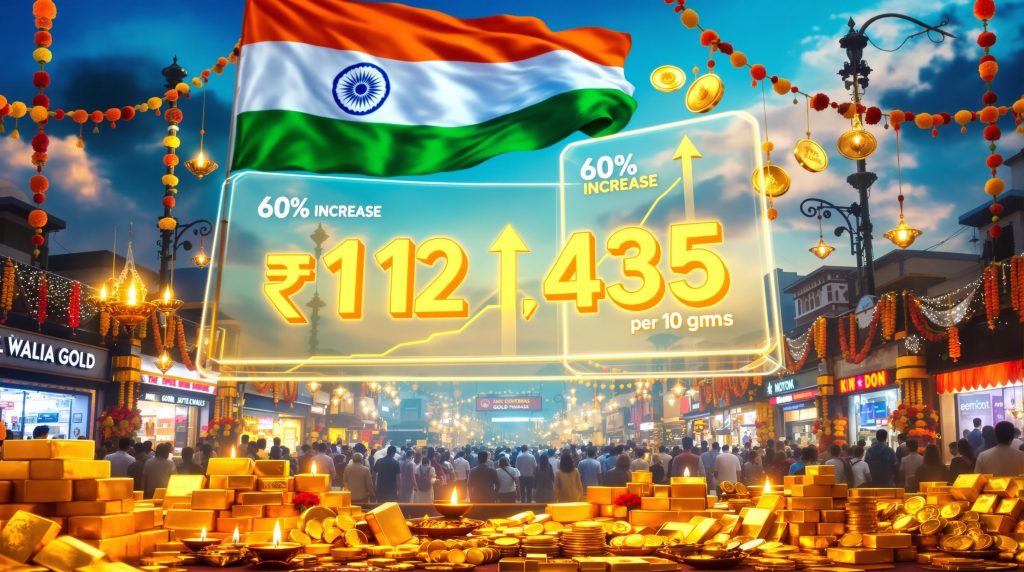Understanding India's Shifting Gold Market Dynamics
Record gold prices India festival demand has reached unprecedented levels as the precious metals market experiences dramatic shifts during traditional celebration periods. The transformation affecting India's gold purchasing patterns represents one of the most significant market disruptions in recent memory, fundamentally altering how consumers approach their cultural and investment priorities.
The Price Surge That's Changing Everything
Gold prices in India have reached extraordinary levels, with the precious metal hitting a record high of ₹132,294 per 10 grams during the recent festival season. Friday's closing price of ₹127,008 per 10 grams demonstrates the sustained elevation that has characterized the market throughout this critical purchasing period.
The more than 60% price increase compared to the previous year's Dhanteras festival represents a seismic shift that has forced consumers to completely recalibrate their purchasing strategies. This dramatic appreciation significantly outpaced other investment alternatives, with India's NSE Nifty 50 share index managing only a modest 5% gain during the same timeframe.
Consumer purchasing power has been severely impacted by these elevated price levels, creating a fundamental tension between cultural obligations and economic realities. The psychological impact of crossing traditional price thresholds has led to widespread behavioural changes among buyers who previously considered gold purchases routine during festival periods.
India's Role as a Global Gold Market Driver
As the world's second-largest gold consumer, India's festival seasons create concentrated demand spikes that reverberate throughout international markets. The country's massive consumer base generates purchasing volumes that can influence global price dynamics, particularly during culturally significant periods when millions of households traditionally acquire precious metals.
Indian buying patterns during festivals like Dhanteras and Diwali represent some of the most concentrated gold demand events globally. The cultural significance of these purchases means that price sensitivity operates differently compared to purely investment-driven markets, though the current unprecedented price levels are testing even these deeply rooted traditions.
Furthermore, our record gold highs analysis reveals that the ripple effects of Indian demand patterns extend far beyond domestic borders, with international dealers and suppliers closely monitoring festival seasons to anticipate supply requirements and price movements across global precious metals markets.
What's Driving the Shift from Jewelry to Investment Gold?
The Economics Behind Consumer Choices
Manufacturing charges adding 10-20% of the gold price as premiums to jewellery purchases have become a decisive factor in consumer decision-making. These additional costs, which represent pure markup rather than gold value, have made traditional jewellery purchases prohibitively expensive for many buyers during this high-price environment.
Coins and bars now offer direct gold exposure without the manufacturing premiums that inflate jewellery costs. This fundamental economic advantage has led to a strategic reallocation of purchasing preferences, with investment-grade products becoming the preferred vehicle for festival gold acquisitions.
Price sensitivity has reached levels that force even culturally motivated buyers to make strategic calculations about how to maximise their gold exposure while minimising additional costs. The economic logic of avoiding manufacturing charges has overcome traditional preferences for ornamental purchases in many cases.
Volume vs. Value Analysis
| Purchase Type | Volume Change | Market Impact | Consumer Preference Shift |
|---|---|---|---|
| Gold Jewellery | 30% decline | Significant reduction | Moving toward investment products |
| Gold Coins/Bars | Strong growth | Flying off shelves | Heavily preferred |
| Overall Sales | 10-15% volume drop | Higher total values | Strategy-driven choices |
Gold jewellery demand experienced a nearly 30% drop compared to the previous year, representing one of the most dramatic shifts in purchasing patterns observed during recent festival seasons. This decline reflects consumers' strategic response to the compounding effect of high gold prices plus manufacturing premiums.
Conversely, coins and bars experienced exceptional demand, with industry officials describing them as moving rapidly through retail channels. The stark contrast between jewellery and investment product performance illustrates how economic factors can override traditional cultural preferences when price pressures become extreme.
Overall sales volumes declined 10-15% compared to the previous year, though total transaction values increased dramatically due to elevated prices. This dynamic created a market paradox where fewer physical transactions generated higher revenue streams for dealers and retailers.
How Are Festival Traditions Adapting to Market Realities?
Dhanteras and Diwali Buying Patterns
Traditional auspicious purchasing has maintained its cultural significance despite economic pressures, with retailers extending operating hours to accommodate sustained demand throughout the festival period. Jewellery stores remained open until midnight during Dhanteras, with the auspicious buying period continuing into the following afternoon to maximise purchasing opportunities.
The cultural importance of festival gold purchases has proven remarkably resilient, even as consumers modify their purchasing strategies to accommodate price realities. The timing and cultural significance of these acquisitions remain unchanged, while the specific products and quantities have adapted to economic constraints.
Extended shopping hours reflect retailers' recognition that concentrated demand periods require maximum accessibility to capture available purchasing power. The industry's commitment to maintaining traditional shopping patterns demonstrates the enduring cultural importance of festival gold acquisitions.
Regional Market Responses
Dealer premiums have reached up to $25 per ounce above official domestic prices (inclusive of 6% import and 3% sales levies), representing the highest premium levels in more than a decade. These elevated premiums reflect strong domestic demand relative to available supply, creating significant price pressure beyond international gold price increases.
The premium structure indicates that import demand remains robust despite elevated international prices, with dealers able to command substantial markups due to sustained consumer interest. Regional variations in premium levels reflect local supply-demand dynamics and competition among dealers serving different market segments.
Government levies totalling 9% (6% import duty plus 3% sales tax) add significant cost burden beyond international gold prices, contributing to the overall price pressure facing Indian consumers during festival periods.
What Strategies Are Retailers Using to Maintain Sales?
Industry Adaptation Mechanisms
The gold industry has implemented strategic discounts on jewellery manufacturing charges to maintain purchasing momentum throughout festival and wedding seasons. These promotional strategies represent direct responses to price sensitivity that threatens traditional sales patterns.
Retailers have developed comprehensive approaches to address price resistance:
• Manufacturing charge discounts reducing the premium burden on jewellery purchases
• Extended financing options allowing consumers to spread costs over time
• Exchange programmes for old gold to offset new purchase costs
• Lightweight design offerings reducing total purchase amounts while maintaining ornamental appeal
The industry's response demonstrates sophisticated understanding of price elasticity in culturally motivated markets. By reducing the variable costs associated with jewellery manufacturing, retailers can partially offset the impact of elevated gold prices on consumer purchasing power.
Market Response to Price Pressures
Lightweight jewellery designs have gained popularity as consumers seek to maintain cultural purchasing traditions while managing total expenditure levels. These products allow buyers to acquire traditional ornamental items without the full financial impact of standard-weight pieces.
Smaller denomination coins have become preferred choices among investment-focused buyers, enabling participation in gold markets with reduced capital requirements. The availability of fractional gold products has democratised access during high-price periods.
In addition, effective gold investment strategies demonstrate that focus on affordability without sacrificing cultural significance has become a central theme in product development and marketing strategies. Retailers recognise that maintaining cultural relevance while addressing economic constraints requires innovative approaches to traditional product offerings.
Industry leaders expressed confidence that extended operating hours and promotional strategies would help sustain purchasing momentum despite unprecedented price challenges, demonstrating their commitment to serving traditional festival demand patterns.
How Do Economic Factors Support Continued Gold Demand?
Macroeconomic Drivers
| Economic Factor | Market Impact | Supporting Demand |
|---|---|---|
| Equity Performance | NSE up 5% vs gold's 60% | Gold significantly outperforming |
| Currency Dynamics | Ongoing concerns present | Driving protective gold buying |
| Investment Flows | Strong ETF inflows | Institutional support building |
| Festival Timing | Cultural obligations maintained | Traditional demand preserved |
The dramatic outperformance of gold compared to equity markets has created compelling investment narratives that support continued demand despite high prices. Gold's 60% appreciation significantly exceeded the 5% gain in India's primary stock index, reinforcing precious metals' role as preferred investment vehicles.
Exchange-traded funds backed by physical gold and silver have experienced strong inflows in recent months, indicating institutional and sophisticated investor interest in precious metals exposure. These investment flows provide fundamental demand support beyond traditional retail purchasing.
Moreover, the gold price forecast suggests continued upward pressure, which further validates investor confidence in precious metals markets.
Investment Demand Trends
Physical gold has maintained its appeal over financial instruments among Indian consumers, reflecting deep-seated preferences for tangible asset ownership. The cultural and psychological aspects of physical possession continue to influence purchasing decisions even during high-price environments.
Wealth preservation motives have intensified as economic uncertainties and currency concerns drive defensive investment strategies. Gold's traditional role as a store of value becomes particularly relevant during periods of elevated geopolitical and economic uncertainty.
Portfolio diversification strategies increasingly incorporate precious metals as essential components, with investors recognising gold's low correlation with other asset classes. The metal's defensive characteristics provide portfolio insurance that justifies premium pricing for many buyers.
What Does Silver's Performance Mean for Precious Metals?
Silver as an Alternative Investment
Strong demand across silver coins, bars, and jewellery has emerged as a significant trend during the current festival season. The white metal's performance has attracted increased attention from investors seeking precious metals exposure at more accessible price points compared to gold.
Industry representatives have noted dealer expectations that silver could outperform gold, creating additional investment interest in the alternative precious metal. This optimism has translated into measurable demand increases across various silver product categories.
The affordability advantage of silver relative to gold has made it an attractive entry point for new precious metals investors, while existing gold holders diversify their holdings to include silver exposure.
Diversification Strategies
Consumers have increasingly explored silver as a more affordable precious metals option while maintaining their overall investment objectives in the sector. This shift reflects sophisticated understanding of precious metals markets and strategic allocation approaches.
Portfolio balancing between gold and silver has become more common as investors seek to optimise their precious metals exposure while managing total capital requirements. The correlation benefits of holding both metals provide enhanced diversification advantages.
Industrial demand factors supporting silver fundamentals add an additional investment thesis beyond pure precious metals speculation, creating multiple demand drivers that enhance long-term prospects for the white metal.
How Are Global Factors Influencing Indian Gold Markets?
International Price Transmission
Global gold market dynamics directly impact domestic Indian prices through import mechanisms and international arbitrage relationships. The transmission of international price movements into local markets occurs rapidly due to India's position as a major importing nation.
Currency fluctuations between the US dollar and Indian rupee add complexity to domestic gold pricing, creating additional volatility beyond international gold price movements. These exchange rate effects can amplify or moderate international price changes for Indian consumers.
Import duties and taxes significantly affect final consumer prices, with the combined 9% levy structure (6% import duty plus 3% sales tax) adding substantial cost burden beyond international market prices.
Supply Chain Considerations
Import demand has remained robust despite elevated prices, indicating underlying strength in Indian gold consumption patterns. The willingness to pay premium prices demonstrates the enduring cultural and investment appeal of gold in Indian society.
Dealer inventory management strategies have adapted to accommodate high-price environments while maintaining adequate supply for festival demand periods. The balance between inventory carrying costs and supply security requires sophisticated planning during volatile price periods.
However, as noted in our comprehensive gold market performance analysis, premium structures reflect market clearing mechanisms where domestic demand exceeds easily available supply, creating profitable arbitrage opportunities for importers and dealers willing to manage the associated risks.
What Are the Implications for Future Festival Seasons?
Price Sensitivity Analysis
Consumer adaptation to sustained high prices suggests that demand patterns may permanently shift toward more price-conscious purchasing behaviours. The current festival season represents a stress test for traditional buying patterns under extreme price conditions.
Potential for demand recovery if prices moderate remains uncertain, as behavioural changes adopted during high-price periods may persist even if market conditions improve. Consumer learning effects from the current experience may have lasting impacts on future purchasing patterns.
Long-term cultural demand continues to provide fundamental price support, though the specific manifestation of this demand may evolve toward more investment-focused products rather than traditional jewellery purchases.
Market Evolution Predictions
The continued shift toward investment-grade gold products appears likely to persist as consumers have discovered the economic advantages of avoiding manufacturing premiums. This structural change may permanently alter the composition of Indian gold demand.
Technology integration in retail experiences may accelerate as dealers seek to enhance customer engagement and provide value-added services that justify premium pricing in competitive markets.
Furthermore, the broader market implications of the gold price surge record indicate that demographic changes affecting purchasing patterns could influence future demand structures, with younger consumers potentially more willing to adopt investment-focused approaches compared to traditional ornamental purchasing preferences.
Global Perspectives on Festival Gold Demand
According to Gold.org's India market update, the festival season's impact extends beyond national borders, with global markets closely monitoring Indian purchasing patterns. This international attention underscores India's critical role in worldwide gold price formation.
Additionally, market observers note that Gulf Business reports on Indian festive demand demonstrate how regional markets respond to concentrated Indian buying, creating interconnected price dynamics across international trading centres.
Navigating India's Evolving Gold Landscape
The transformation of India's gold market during this festival season reflects broader economic realities where traditional purchasing patterns adapt to unprecedented price environments. Record gold prices India festival demand has created a natural experiment in consumer behaviour that reveals the interplay between cultural traditions and economic pragmatism.
While festival demand retains its cultural significance, the pronounced shift toward investment-focused products demonstrates consumer sophistication in navigating high-price markets. The industry's response through financing options, manufacturing charge discounts, and innovative product offerings shows remarkable market resilience in the face of challenging conditions.
The current market dynamics suggest that India's role as a major global gold consumer will continue to drive market evolution, balancing deep cultural traditions with evolving economic realities. As uncertainty continues supporting precious metals demand globally, India's adaptive consumer behaviour and industry responses will likely serve as a model for other major consuming markets facing similar price pressures.
The lessons learned from this festival season may fundamentally reshape how Indian consumers approach precious metals acquisition, potentially creating lasting changes in the world's second-largest gold market that extend far beyond current price cycles.
Disclaimer: This analysis involves market predictions and speculation based on current trends. Future market performance may differ significantly from current patterns, and readers should conduct their own research before making investment decisions.
Considering Precious Metals Investment Opportunities?
Discovery Alert's proprietary Discovery IQ model delivers real-time alerts on significant mineral discoveries across the ASX, including precious metals companies that could benefit from the current gold market dynamics. Subscribers gain immediate access to actionable insights on potential discoveries before the broader market, positioning themselves ahead of major announcements that could capitalise on elevated precious metals demand from markets like India's festival-driven consumption patterns.




